Zalman HD-160 and Accompanying Products
by Joshua Buss on March 31, 2006 12:05 AM EST- Posted in
- Cases/Cooling/PSUs
VF700-Cu-LED
With so much Zalman equipment already in this setup, it seems almost silly not to go all-out at this point, so that's exactly what we decided to do.
The stock cooler on our 6600GT has always been the subject of some concern of ours, due to the high temperatures reported by the driver software, and the rather audible noise of the fan.
The package includes the heat sink assembly, eight individual ramsinks for the dedicated GPU memory, mounting hardware for both typical ATI and NVIDIA cards, and thermal compound for maximum heat transfer.
The hardest part about installing the VF700 for many cards is probably simply getting the stock cooler off the graphics card safely. Many stock coolers have a strong adhesive-style of thermal paste holding the cooler in place, which can make removing it potentially dangerous. One simply has to be careful to pull slowly and apply enough of a twisting force to prevent damaging the core of the processor.
Once the stock cooler was removed and the GPU surface cleaned, we proceeded to install the Zalman mounting kit which uses another back plate design, which holds itself steady to the card first.
The back plate is held in place using special nuts, which are threaded on both sides. The one on the right in the following picture has already been screwed in place, while the one on the upper left corner only has one of the rubber washers installed so far.
The heat sink/fan combination, which bears a strong resemblance to the popular 7000 series CPU coolers from Zalman, bolts down into these special fasteners, again using only two points to keep as even pressure between the two surfaces as possible.
As this is the first time in a while since we've looked at cooling equipment, perhaps we should mention that there are always a few drawbacks to installing aftermarket heat sinks to any piece of hardware in your computer. Things to consider include voiding warranties and risking the possibility of damaging the hardware due to either physical damage during the installation or an improper installation, which leads to overheating of the equipment. However, simply taking care to follow all instructions and working slowly enough to do everything carefully is normally all it takes to make installing your own third-party cooling equipment enjoyable and rewarding.
With so much Zalman equipment already in this setup, it seems almost silly not to go all-out at this point, so that's exactly what we decided to do.
The stock cooler on our 6600GT has always been the subject of some concern of ours, due to the high temperatures reported by the driver software, and the rather audible noise of the fan.

The package includes the heat sink assembly, eight individual ramsinks for the dedicated GPU memory, mounting hardware for both typical ATI and NVIDIA cards, and thermal compound for maximum heat transfer.
The hardest part about installing the VF700 for many cards is probably simply getting the stock cooler off the graphics card safely. Many stock coolers have a strong adhesive-style of thermal paste holding the cooler in place, which can make removing it potentially dangerous. One simply has to be careful to pull slowly and apply enough of a twisting force to prevent damaging the core of the processor.
Once the stock cooler was removed and the GPU surface cleaned, we proceeded to install the Zalman mounting kit which uses another back plate design, which holds itself steady to the card first.
The back plate is held in place using special nuts, which are threaded on both sides. The one on the right in the following picture has already been screwed in place, while the one on the upper left corner only has one of the rubber washers installed so far.
The heat sink/fan combination, which bears a strong resemblance to the popular 7000 series CPU coolers from Zalman, bolts down into these special fasteners, again using only two points to keep as even pressure between the two surfaces as possible.
As this is the first time in a while since we've looked at cooling equipment, perhaps we should mention that there are always a few drawbacks to installing aftermarket heat sinks to any piece of hardware in your computer. Things to consider include voiding warranties and risking the possibility of damaging the hardware due to either physical damage during the installation or an improper installation, which leads to overheating of the equipment. However, simply taking care to follow all instructions and working slowly enough to do everything carefully is normally all it takes to make installing your own third-party cooling equipment enjoyable and rewarding.


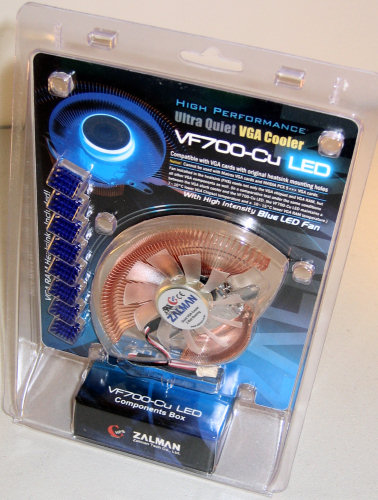
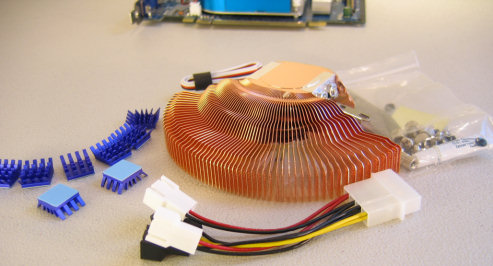
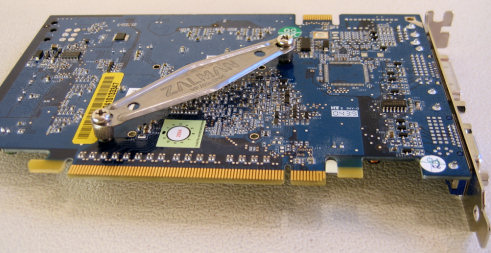
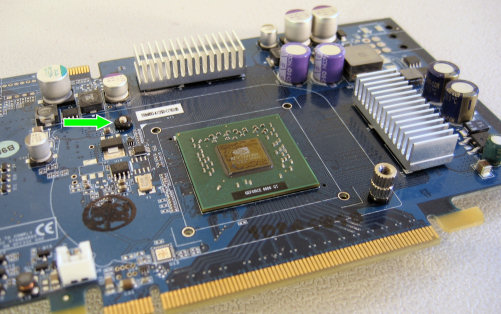
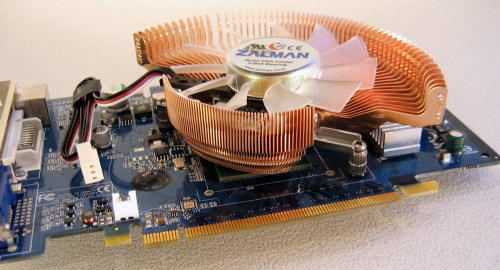








48 Comments
View All Comments
Stele - Monday, April 3, 2006 - link
Good post, well said.As for using BJTs in audio power amps, I agree with you. It's a good thing... properly selected and implemented, they're generally known to give better sound than FETs (especially in the form of substantially lower distortion and noise figure), as much as triodes/vacuum tubes have excellent distortion and noise characteristics. I used an all-discrete, all-BJT design for an audio power amp competition several years ago; trickier to get right but ultimately satisfying sound quality compared to some designs that took the short cut and dropped in power-amp ICs (mostly from ST, IIRC). :P
Stele - Sunday, April 2, 2006 - link
Hi topher42,Now how did that slip by me... yes, you're perfectly right. Was trying to be careful not to make that mistake but in the end still tripped on that common misuse of the term. Thank you for pointing it out, I stand corrected :)
20kW amps??? That's powerful alright, no surprise about being a headache to keep cool :)
I mentioned TO-3's along with the other packages to illustrate my point that discrete MOSFETs don't always have to come in 3-legged form, though you're right that they're a big too big for motherboard mobos.
I see your point, and it kind of explains certain things nowadays... oh well, gone were the hands-on approach of the good old days :P
Hi Clauzii
As with topher42 you're right that a discrete MOSFET is not an 'IC', srictly-speaking. I really must be more careful not to mix them up!
However, a MOSFET is not really a "constructional technique in a transistor"; rather, it is a transistor (the most common type of FET, of which there are several kinds) that is made using a particular constructional technique (metal/polycrystalline on gate oxide on silicon etc as opposed to bipolar junctions on BJTs) and that works using a particular method of operation (field effect, as opposed to BJTs). :)
Hi AnnonymousCoward,
Granted not the most common in the objective sense, and you may not need to work with them much unless you're involved in, say, power circuitry design. After all, you did mention that you normally use BJTs more. :)
However, it is really common enough in terms of availability and application that it's about universally known, like the 'regular' BJT, especially in (but not limited to) the semiconductor community/industry. Besides, major semiconductor companies sport hundreds to more than a thousand of such devices in their product lists and they're used in an enormous number of electronic devices, from handphones to motherboards to power amplifiers (audio and electrical).
MOSFETs are used in many (dare I say most?) modern power supply applications in electronic devices these days, especially in switch-mode (as opposed to linear) power supplies. Briefly, the MOSFETs in such power supplies are used as digital 'switches' that are rapidly turned on and off a hundred or more times a second to provide power - the amount of power required is varied by changing their duty cycle (how long they stay ON or OFF). This is a whole field by itself, so no-one can blame you if you're not thoroughly familiar with it (I don't pretend to be either! :P).
Relays are used as mechanical switches that isolate two or more circuits yet allow one to control the other(s). A common (but certainly not only use is to allow a low-voltage low-current circuit to control/switch a high-voltage high-current circuit, e.g. when you use a battery-powered light-sensing circuit to turn your room light on.
Opto-couplers and FETs (in the form of solid-state relay ICs) can do the job too, but relays are cheap, readily available, fairly reliable, easy to troubleshoot and generally can handle more current and voltage than a semiconductor counterpart. Of course, relays are bulky, noisy, can introduce damaging surges in the energising circuit when switching on and off (due to the inductance of the coil), and cannot switch as fast as a semicon equivalent, but that's the way it is :)
Clauzii - Sunday, April 2, 2006 - link
To repeat myself:MOS-FET is a constructional technique in a transistor, be it a small one inside a IC or a single "gate" in a device.
An IC is more than one component in the same housing. The MOS-FETs used on mobos are NOT ICs, but Field Effect Transistors made using Metal On Silicon process.
Clauzii - Sunday, April 2, 2006 - link
PS: When do DT check up on their f...... Forum System - it´s flawed like h... :)Clauzii - Sunday, April 2, 2006 - link
To repeat myself:<b>MOS-FET is a constructional technique in a transistor, be it a small one inside a IC or a single "gate" in a device. </b>
An IC is more than one component in the same housing. The MOS-FETs used on mobos are NOT ICs, but Field Effect Transistors made using Metal On Silicon process.
topher42 - Sunday, April 2, 2006 - link
stele."especially since a MOSFET is an IC."
What are you calling integrated?
Most power fets are one transistor
and nothing else in the package.
Not much integration.
Most of the 6 pin devices I have used
were for low current noise differential
inputs were you wanted identical devices
and temperature tracking.
And I have used the big packages when
designing and building 20 kilowatt
amplifiers. Pain to cool....
I was pointing out that the bios would
have a problem controlling the cpu voltage
without power fets. to3's would be a
little big for that app.
The EE's I deal with that don't know a
fet from an asic are usually the digital
designers designers that never get closer
to a part than their VHDL code.
Clauzii - Saturday, April 1, 2006 - link
Nice with a guy that knows what he´s talking about :)Also, almost all amplifiers for professional use (including old estimated Hafler P500, Crown, Ampeq etc.) are build whith MOS-FETs in single TO-3 (metal) etc. housings.
MOS-FET is a constructional technique in a transistor, be it a small one inside a IC or a single "gate" in a device.
nullpointerus - Saturday, April 1, 2006 - link
I'd just like to put my vote in for "geeky electrical thingies."Seriously, does this matter to 99% of the readers?
SonicIce - Friday, March 31, 2006 - link
It's official! Joshua Buss of Anandtech does bad case wiring jobs!JoshuaBuss - Friday, March 31, 2006 - link
Believe it or not, I don't do 'great' wiring jobs inside cases for testing as a matter of choice. Typically, users don't spend enough time routing cables neatly enough to stop all airflow blocking problems, thus I feel it's more accurate to actually leave a little cable clutter behind. Besides, if I spend much more time on it than the average user would, I'm not providing a good sense of how easy it is to do the cable management - I'd simply be showing off. The best way to give people a sense of how the case is laid out is to spend roughly the same amount of time in each case trying to clean them up a bit and see how far I get. With this case, I was able to get the majority of the mess out of the way with almost no effort, which is a testamanet to the ample space inside the HD-160.